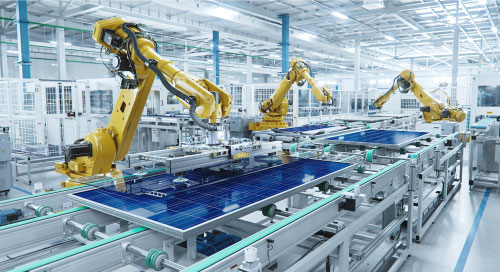Fill form to unlock content
Error - something went wrong!
Stay up to date with the latest IoT and network edge news.
Subscribed.
IPCs and Virtualization: The Future of Smart Factories

Industrial PCs (IPCs) have been instrumental in advancing Industry 4.0. They’ve helped manufacturers move away from hard-to-manage, proprietary programmable logic controllers (PLCs) to software-defined industrial control applications running on open systems like Windows and Linux.
The upside has been enormous. But manufacturers are still looking for better ways to gather and analyze data from the factory floor, unify their technology stack to improve efficiency, and facilitate IT/OT convergence.
IPCs are a natural first step on the road to the smart factory, but early versions lacked the flexibility to take full advantage of the possibilities offered by virtualization technologies.
These powerful edge computing systems enable agile and rich data acquisition—while also being easier to manage, more cost-effective, and more flexible than proprietary systems of the past.
New IPC Platforms—New Edge Benefits
Multi-purpose IPC platforms like those designed by Shenzhen Datang Computer Company, a manufacturer of IPC systems offer the advantages of traditional industrial computing systems: high-performance, low-power processing, high availability, ruggedized design, and an excellent platform for real-time analytics.
But the real magic of these platforms is the performant computing they deliver to run modern software virtualization technologies, enabling multiple workloads to run on a single system. There are consolidation and security benefits as well since software developers can easily port their existing industrial applications to the latest IPC technologies—taking advantage of hardware and software stacks improvements.
This also reduces complexity and costs, making it easier for factory personnel to maintain and monitor systems factory wide. Plus, depending on the underlying platform, multi-purpose IPCs can add value through a unified suite of software tools that deliver better insights into factory data, optimize performance, and speed development work.
Datang’s platform, for example, leverages specific Intel industrial software technologies:
- Intel® Edge Controls for Industrial (Intel® ECI), a modular software reference platform that enables a multi-purpose ICS to run on general-purpose hardware. Intel ECI significantly reduces the difficulty of upgrades and updates for manufacturers. The platform also supports real-time analytics capabilities, virtualization for workload integration, and configurable software modules to meet the performance demands of industrial computing, reduce costs, and improve flexibility.
- Intel® Industrial Edge Insights Platform (Intel® EII), an open-source software platform for IIoT applications that offers data collection, storage, analysis, visualization modules, and containerized deployment. Optimized for Intel hardware and integrated with the Intel® OpenVINO™ toolkit, Intel EII accelerates the development of edge AI solutions, offers better insights into data, and helps businesses get to market faster.
For Datang, using Intel technology has been crucial. Intel is unmatched as a performant, stable hardware platform for industrial edge computing. And their software tools have been just as important in shortening our development time and bringing our solution to market.
Virtualization—the Platform for Software Defined ICS
In addition to helping manufacturers move to open systems and consolidate their hardware/software stack, multi-purpose IPCs offer another significant advantage: built-in virtualization technologies that run on a unified, easy-to-manage platform.
The benefits of virtualization for industrial computing have been apparent for some time now—for example, as a means of upgrading infrastructure without disrupting operations.
Virtualization is, first and foremost, a powerful way to separate computer resources from their underlying hardware. It also improves cybersecurity since computing systems can be subdivided more easily into discrete security environments. But perhaps the greatest benefit of virtualization is workload consolidation—putting idle computing resources to use, improving efficiency, and reducing costs.
The greatest benefit of #virtualization is workload consolidation—putting idle computing resources to use, improving efficiency, and reducing costs. @MaxtangPC via @insightdottech
Multi-Purpose IPCs and the Future of Industrial Control
In the years to come, flexible industrial computing systems that incorporate virtualization technologies will attract more and more attention in the manufacturing sector.
In part, this will be because of advancements in the field of industrial computing. For example, Datang is already looking into integrating Type 1 hypervisors into their products. Also known as “bare metal” hypervisors, Type 1 hypervisors run directly on the underlying hardware without needing a host operating system. This allows for more efficient resource allocation, improved performance, and better security. The benefits in a manufacturing context are perhaps self-evident—but with the growth of IIoT, even more attractive Type 1 hypervisor and virtualization technologies are on the horizon.
One exciting possibility is the ACRN reference hypervisor, an open-source virtualization tool that is purpose-built for embedded IoT development. ACRN hypervisors solve data center issues that manufacturers find particularly burdensome: lengthy boot times, high costs, and significant development overhead. ACRN will help move Industry 4.0 closer to open-platform, software-defined industrial computing.
But the main draw of multi-purpose IPC platforms will be how well they solve problems for multiple stakeholders.
For OEM/ODMs, the ease of development offered by modern IPC platforms means they can focus on meeting manufacturers’ needs without having to worry about steep R&D costs. And for builders and operating technology systems integrators, who tend to deal with smaller batch orders, development costs will also come down thanks to the flexibility and customizability of these platforms.
For the manufacturers, of course, the advantages are crystal clear. Multi-purpose IPC platforms offer simpler, easier-to-manage access to all those benefits that motivated their digital transformation in the first place: real-time control, improved product quality, reduced costs, and a faster route to innovation.
Edited by Georganne Benesch, Associate Editorial Director for insight.tech.